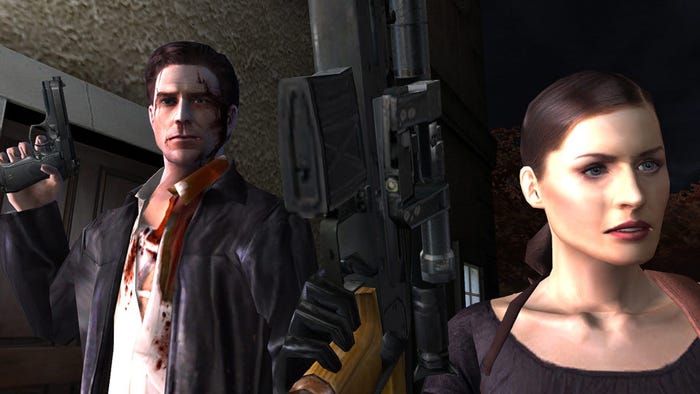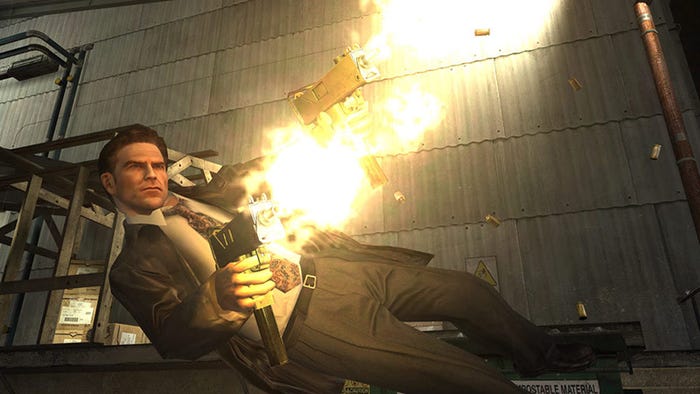Trending
Opinion: How will Project 2025 impact game developers?
The Heritage Foundation's manifesto for the possible next administration could do great harm to many, including large portions of the game development community.

Twenty years ago, Remedy released Max Payne 2: The Fall of Max Payne, a gritty, neo-noir shooter that features gunslinging sequences of feverish proportions, its pulpy violence enacted by a gruff, cynical detective, a broken shell of a man. Like Max Payne’s dramatic monologues, which could barely disguise the torrent of anguish in his voice. He mutters lines like “the genius of the hole: no matter how long you spend climbing out, you can still fall back down in an instant."
The shooter itself feels almost operatic, characterized by how it elevates what worked so well in the original: its slow-mo, bullet time gun-fu, relentlessly elaborate shootouts, and that rich, grimy film noir atmosphere.
Despite its age, the vintage shooter’s legacy still rings today, even with Remedy largely pivoting to horror-adjacent games like Control and Alan Wake.
Far from being tarnished by time, the intricacies of Max Payne 2 still continue to inspire developers across genres today.
One such lesson has to do with standing by a bold, creative decision: the disappearance of Payne’s perpetual grimace. The angular mug of the series’ writer Sam Lake, etched onto the titular hero’s face in the original, was replaced by the brooding good looks of actor Timothy Gibbs. Lake’s iconic smirk was so memorable that mods centered on bringing back his likeness in subsequent sequels were immensely popular.
Yet this also adds a layer of absurdity to the original’s bleak, hardboiled fiction—a visage that seems out of place within the unrelentingly dour environments in Max Payne 2.
“There's some people who object to [Payne’s face change], but Max Payne 2 is where you see Remedy coming off this smash hit [to] really establish Max Payne as his own character. Not goofily attached to any meta joke, but standing in his own right,” says Xalavier Nelson Jr, studio head of Strange Scaffold, with his team recently releasing a Max Payne-inspired shooter called El Paso, Elsewhere.
This, according to him, is one of the ways the sequel refined the Max Payne formula: shoulder-busting a door right into a crowded room as you shoot a bunch of gunslinging goons in slow-mo, set amidst the grungy underbelly of New York City.

Image via Rockstar Games.
But this change is more than just skin deep, with Max Payne 2 largely elevating what works so well in the original with several subtle but incisive adjustments.
“I think it perfected a lot of things that the first Max Payne toyed around with. You can see the blueprint of the known "Remedy style" being laid out here in full. While on paper it doesn't add much over the first game, the execution [in Max Payne 2] is a much-improved sum of parts,” says Max Ylitalo, the lead level designer behind first-person shooter Ion Fury.
Katherine Baskin, the social media & community manager at Arrowhead Game Studios, sees the game as capturing the zeitgeist of gaming back in the early 2000s. “[Max Payne 2] managed to be astonishing on top of it. Of course, it has its warts, like absolutely every great work of art.
But back then, it was a sequel that defied the sequel formula: it didn’t just give me more of the same game. It grew the world, it improved and polished the impressive technology, and it felt like a fitting closure to Max’s journey as a Remedy character,” says Baskin.
Take the dirty, double-crossing drama in the Max Payne series, which lends a sense of depravity to Payne’s countless misfortunes. The first game is classic Raymond Chandler: Payne’s a hardened cop who was irreversibly broken by the death of his wife and baby and framed for his colleague’s murder as he sought vengeance within the city’s criminal underworld.
The sequel, however, took his personal tragedy in a slightly different direction: film noir. Payne has been reinstated as a detective for the NYPD, but his inner demons still plague his sleepless nights. While investigating a gunfight at a warehouse, he was mired in yet another elaborate scheme between mobsters and corrupt cops.

Image via Rockstar Games.
And then there’s the femme fatale and Payne’s love interest: a hired gun named Mona Sax. All these are narrated with the morose melodrama of a deeply cynical Payne: “Like all the bad things in my life, it started with the death of a woman. I couldn't save her.”
Interspersed between chapters are the comic book cutscenes the original game popularized, but traditional video cutscenes are also introduced with cinematic aplomb, such as the introduction of key characters like Valerie Winterson, Vladimir "Vlad" Lem and Vinnie Gognitti.
“You see for their narrative design, and cutscene principles, [there are] suddenly way more cutscenes, take place in 3D fully animated, real-time cutscenes. But they still retain, especially for large, milestone moments, the comic stylings, because Remedy is exceptionally good at recognizing what speaks to people about their previous games, especially games in a franchise,” says Nelson Jr. Losing the graphic novel panels might have been disastrous; after all, their almost monochromatic frames have added dimensions to Max Payne 2’s gritty noir atmosphere.
“When it came to the sequel, you can see that it's much less of a disconnected narrative; pieces just can’t be rearranged around. Most evident from comparing the first moments of said games, Max Payne 1 jump cuts to a conclusion that sort of already hints some closure to the prologue itself, where Max Payne 2 puts you at his worst point in the game, loading you with questions and a twist.
Everything you see or do is tied to the main narrative and prologue. I think the focus ultimately allowed a much better story and a map set as well [...] it is just a much more coherent game in the end,” says Ylitalo.
Bullet time is another example of how Remedy reinforced what works for the first game within Max Payne 2. It’s a mechanic seemingly plucked from The Matrix but also a homage to the stylized action scenes of Hong Kong crime thrillers. In short, bullet time lets players slow down the environment around them in order to dodge bullets better but also land precise shots.
While it’s a skill that transforms gunplay into a balletic experience, with players able to take on hoards of goons, combat is still a challenging affair in the original. To this end, this feature was tweaked such that shootouts are more manageable. “Bullet time was enhanced a bit, to a version 2.0, if you will,” says Peter Hajba, who worked on the original Max Payne and its sequel as an animator, particle effects artist and sound designer, and is now a sound designer at Avalanche Studios.
In particular, bullet time sequences are prolonged the more enemies are cleared. “When you look at the combat, they add this entire invisible combo system to push the player forward and drive them to have more momentum in their slow motion gameplay,” says Nelson Jr. “But when [Remedy is] looking at things that they can amplify, they're like… in slow motion when you reload, suddenly you’ll do a sick little spin-around reload and it makes no sense. But It's because they had managed to identify something that really worked about the first game,” says Nelson Jr.
This reloading feature, in particular, lets the player cut down precious seconds when reloading their arsenal while still dodging attacks—a nifty trick that can be applied in a pinch or when Payne’s chosen gun has a modest bullet capacity.
For Ylitalo, enemy encounters were another highlight of Max Payne 2. “Something that the Max Payne games always did well were enemy encounters…you often encounter enemies doing actual things, have conversations or otherwise patrol an area. It really makes you look at combat more as a theater play,” he says.
“If a player triggers enemies, a good combat sequence should always happen organically, in steps and from different times from different directions. with clear sound or fake gun firing cues for the player to mentally map an area during combat. Games like the original Doom did this primitively with monster closets and triggers, but I feel that Max Payne games always excelled at making memorable encounters that you could describe later on as areas or rooms.”
The adaptive difficulty in Max Payne 2’s combat also means that if you die too frequently, the game will become slightly easier. But if you’re breezing through levels, enemies will gradually become tougher to eliminate.

Image via Rockstar Games.
“Max Payne, while still my GOAT (Greatest Of All Time), can be punishing. The reward is in the successful clearing of a room of thugs, but you will save scum like your life depends on it. But in Max Payne 2, it’s a bit more indulgent [when it comes to] the joy of bullet time. It’s more indulgent in almost everything, and so playing through it feels like a more lavish, more cinematic experience than the first,” adds Baskin.
Then there’s the striking good looks (for its time) of May Payne 2, with bodies crumbling with the rigidity of a skeleton, rather than the traditional static death animations prevalent at that time. “We introduced ragdoll physics. No more hand-animated deaths, it was all free tumble with dust clouds, baby,” says Hajba.
There are also other finer details within the game: a greater number of polygons, which offers each character increased fidelity, and much more refined lighting. “In addition to the radiosity baked lighting, the protagonist could now cast a shadow that was accurate to the lights around him, despite the fact there were no point lights in the baked lighting. The light angle was also baked into the world data, and this data was sampled to cast the shadow,” he adds.
Since the release of Max Payne 2 nearly two decades ago, a number of Max Payne clones have since emerged, with these titles clearly enamored with the shoot-dodging and slow-mo combat of the shooter: the likes of El Matador, Double Action Boogaloo and Dead to Rights. More recently, Strange Scaffold’s El Paso, Elsewhere is built upon the gunplay of Max Payne 2 and 3, with the shooter featuring a supernatural hunter tasked with rescuing several hostages while deftly dodging bullets.
“I'd say, one thing that's carried over in my love and respect for Max Payne 2, is its effective use of scripting. There's a lot of very expensive things you can do, to try to make a flashy spectacle, or to put something new on the screen and try to break up the tedium of just shooting waves after waves of enemies. But a lot of those techniques, as flashy and expensive as they are, don't fundamentally actually alter the player's experience,” says Nelson Jr.
“One thing that El Paso, Elsewhere attempts to do, and…which most echoes Max Payne 2, is you're constantly seeing level designers use tricks to confront you, and shake you up [...] and make you approach the space in a different way. So you just don't just hit slow motion, kill all the guys in the room, and move on to the next one…in that way, it had a big impact on El Paso, Elsewhere.”
But 20 years later, little still beats the sensation of playing Max Payne 2 for the very first time: the high-octane, cinematic shootouts set amidst the drudgery of a perpetually gloomy New York City, the dramatic twists and turns of Max Payne 2’s film noir love story, and Payne’s painfully climatic monologues.
“I felt the rise of that old familiar feeling...I hated it...I welcomed it.”
Read more about:
FeaturesYou May Also Like